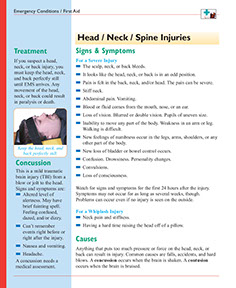CONDITIONS
SYMPTOM CHECKER
Male
Female
Child
Arm, Hand & Shoulder Concerns
Legs & Feet Concerns
Dental & Mouth Concerns
Ear & Nose
Eye Conditions
Head Conditions
Arm, Hand & Shoulder Concerns
Legs & Feet Concerns
Front
Back
Arm, Hand & Shoulder Concerns
Dental & Mouth Concerns
Ear & Nose
Eye Conditions
Head Conditions
Arm, Hand & Shoulder Concerns
Dental & Mouth Concerns
Ear & Nose
Eye Conditions
Head Conditions
Front
Back
Arm, Hand & Shoulder Concerns
Neck Links
Head & Neck Concerns
Arm, Hand & Shoulder Concerns
Neck Links
Head & Neck Concerns
Front
Back
Online Clinic
Wise Healthcare
Head/Neck/Spine Injuries
Signs & Symptoms
For a Severe Injury
• The scalp, neck, or back bleeds.
• It looks like the head, neck, or back is in an odd position.
• Pain is felt in the back, neck, and/or head. The pain can be severe.
• Stiff neck.
• Abdominal pain. Vomiting.
• Blood or fluid comes from the mouth, nose, or an ear.
• Loss of vision. Blurred or double vision. Pupils of uneven size.
• Inability to move any part of the body. Weakness in an arm or leg. Walking is difficult.
• New feelings of numbness occur in the legs, arms, shoulders, or any other part of the body.
• New loss of bladder or bowel control occurs.
• Confusion. Drowsiness. Personality changes.
• Convulsions.
• Loss of consciousness.
Watch for signs and symptoms for the first 24 hours after the injury. Symptoms may not occur for as long as several weeks, though. Problems can occur even if no injury is seen on the outside.
For a Whiplash Injury
• Neck pain and stiffness.
• Having a hard time raising the head off of a pillow.
Concussion
This is a mild traumatic brain injury (TBI) from a blow or jolt to the head. Signs and symptoms are:
• Altered level of alertness. May have brief fainting spell. Feeling confused, dazed, and/or dizzy.
• Can’t remember events right before or right after the injury.
• Nausea and vomiting.
• Headache.
Causes
Anything that puts too much pressure or force on the head, neck, or back can result in injury. Common causes are falls, accidents, and hard blows. A concussion occurs when the brain is shaken. A contusion occurs when the brain is bruised.
Treatment
If you suspect a head, neck, or back injury, you must keep the head, neck, and back perfectly still until EMS arrives. Any movement of the head, neck, or back could result in paralysis or death.
Questions to Ask
Question 1
Does the person have one or more signs and symptoms for a severe injury? {Note: See First Aid for a Severe Injury on this page.}
Get medical care without delay. If symptoms are life threatening go to the ER or call 9-1-1. Don’t call 9-1-1 or use the ER if symptoms do not threaten life. Ask your doctor ahead of time where you should go for a problem that needs prompt care, but not emergency care.
Question 2
Was a recent injury to the head, neck, and/or back not treated with emergency care and are any of these problems present?
• Loss of consciousness, even briefly.
• Confusion. Vomiting. Severe pain. Numbness,tingling, or weakness in the face, arms, or legs. Loss of bladder control.
• A headache has lasted longer than 2 days and gets worse with time. Unusual feeling or sensations. Large or increased area of swelling despite the use of ice.
Get medical care without delay. If symptoms are life threatening go to the ER or call 9-1-1. Don’t call 9-1-1 or use the ER if symptoms do not threaten life. Ask your doctor ahead of time where you should go for a problem that needs prompt care, but not emergency care.
Question 3
After a head, neck, or back injury, do any of these problems occur?
• Pain from a head, neck, or back injury lasts longer than 1 week or goes away and returns.
• Signs of infection (e.g., redness, fever, pus, drainage, etc.) occur at the site of the wound.
• A whiplash injury is suspected.
You should be seen by your doctor for medical advice. Contact your doctor or health care provider to find out how soon you should be seen.
Use Self-Care / First Aid:
You can probably take care of the problem yourself if you answered NO to all the questions. Use the “Self-Care” measures that are listed. Call your doctor if you don’t feel better soon, though. You may have some other problem.
Self-Care / First Aid
First Aid for a Severe Injury
• Do not move the person unless his or her life is in danger. If so, log roll the person, place tape across the forehead, and secure the person to a board to keep the head, neck, and back areas from moving at all.
• Call 9-1-1!
• CHECK for a response. If giving rescue breaths, do not tilt the head backward. Pull the lower jaw open instead.
To Immobilize the Head, Neck, and/or Back
• Tell the person to lie still and not move his or her head, neck, back, etc.
• Log roll as listed above or place rolled towels, etc. on both sides of the neck and/or body. Tie in place, but don’t interfere with the person’s breathing. If necessary, use both of your hands, one on each side of the person’s head to keep the head from moving.
• Monitor for Bleeding and Shock. Keep the person warm with blankets, coats, etc.
Move Someone You Suspect Has Injured His or Her Neck in a Diving or Other Water Accident
Before emergency care arrives:
• Protect the neck and/or spine from bending or twisting. Place your hands on both sides of the neck. Keep it in place until help arrives.
• If the person is still in the water, help the person float until a rigid board can be slipped under the head and body, at least as far down as the buttocks.
• If no board is available, get several people to take the person out of the water. Support the head and body as one unit. Make sure the head does not rotate or bend in any way.
First Aid For Traffic Accidents
• If the person was in a motorcycle accident, do not remove the helmet. Call 9-1-1 to do this.
• Don’t move the person. He or she may have a spinal injury. Call 9-1-1 to do this.
First Aid for Minor Head Injuries
• Put an ice pack or bag of frozen vegetables in a cloth. Apply this to the injured area. Doing this helps reduce swelling and bruising. Change it every 15 to 20 minutes for 1 to 2 hours. Do not put ice directly on the skin. Cover an open, small cut with gauze and first- aid tape or an adhesive bandage.
• Once you know there is no serious head injury, do normal activities again. Avoid strenuous ones.
• Take an over-the-counter medicine for pain as directed.
• Don’t drink alcohol or take any other sedatives or sleeping pills.
• During the next 24 hours, monitor the person. While asleep, wake the person every 2 hours to check alertness. Ask something the person should know, such as a pet’s name, an address, etc. If the person can’t be roused or respond normally, get immediate medical care.
First Aid for Bleeding from the Scalp
• To control bleeding, put pressure around the edges of the wound. Make a ring pad (shaped like a doughnut) out of long strips of cloth to apply pressure around the edges of the wound. If this doesn’t control bleeding, put direct pressure on the wound. Don’t poke your hand into the person’s brain, though.
• Don’t wash the wound or apply an antiseptic or any other fluid to it.
• If blood or pink-colored fluid is coming from the ear, nose, or mouth, let it drain. Do not try to stop its flow.
If You Suspect a Whiplash Injury
• See your doctor, as soon as you can, to find out the extent of injury. If your arm or hand is numb, tell your doctor.
• For the first 24 hours, apply ice packs to the injured area for up to 20 minutes every hour.
• After 24 hours, use ice packs or heat, whichever works best, to relieve the pain. There are many ways to apply heat. Take a hot shower for 20 minutes a few times a day. Use a hot-water bottle, heating pad (set on low), or heat lamp directed to the neck for 10 minutes, several times a day. (Use caution not to burn the skin.)
• Wrap a folded towel around the neck to help hold the head in one position during the night.
This website is not meant to substitute for expert medical advice or treatment. Follow your doctor’s or health care provider’s advice if it differs from what is given in this guide.
The American Institute for Preventive Medicine (AIPM) is not responsible for the availability or content of external sites, nor does AIPM endorse them. Also, it is the responsibility of the user to examine the copyright and licensing restrictions of external pages and to secure all necessary permission.
The content on this website is proprietary. You may not modify, copy, reproduce, republish, upload, post, transmit, or distribute, in any manner, the material on the website without the written permission of AIPM.
2021 © American Institute for Preventive Medicine - All Rights Reserved. Disclaimer | www.HealthyLife.com
















































